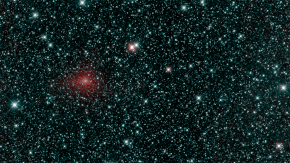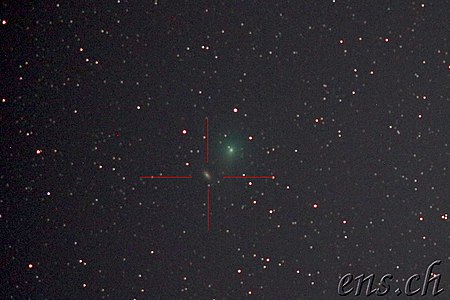
A trans-Neptunian object (TNO), also written transneptunian object, is any minor planet in the Solar System that orbits the Sun at a greater average distance than Neptune, which has an orbital semi-major axis of 30.1 astronomical units (au).

46P/Wirtanen is a small short-period comet with a current orbital period of 5.4 years. It was the original target for close investigation by the Rosetta spacecraft, planned by the European Space Agency, but an inability to meet the launch window caused Rosetta to be sent to 67P/Churyumov–Gerasimenko instead. It belongs to the Jupiter family of comets, all of which have aphelia between 5 and 6 AU. Its diameter is estimated at 1.4 kilometres (0.9 mi). In December 2019, astronomers reported capturing an outburst of the comet in substantial detail by the TESS space telescope.
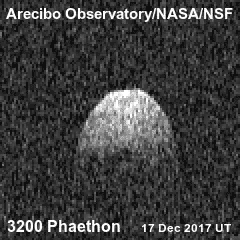
3200 Phaethon, provisionally designated 1983 TB, is an active Apollo asteroid with an orbit that brings it closer to the Sun than any other named asteroid. For this reason, it was named after the Greek myth of Phaëthon, son of the sun god Helios. It is 5.8 km (3.6 mi) in diameter and is the parent body of the Geminids meteor shower of mid-December. With an observation arc of 35+ years, it has a very well determined orbit. The 2017 Earth approach distance of about 10 million km was known with an accuracy of ±700 m.

Comet Bennett, formally known as C/1969 Y1, was one of the two bright comets observed in the 1970s, along with Comet West and is considered a great comet. The name is also borne by an altogether different comet, C/1974 V2. Discovered by John Caister Bennett on December 28, 1969, while still almost two AUs from the Sun, it reached perihelion on March 20, passing closest to Earth on March 26, 1970, as it receded, peaking at magnitude 0. It was last observed on February 27, 1971.
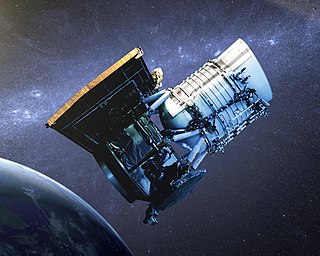
Wide-field Infrared Survey Explorer is a NASA infrared astronomy space telescope in the Explorers Program launched in December 2009. WISE discovered thousands of minor planets and numerous star clusters. Its observations also supported the discovery of the first Y-type brown dwarf and Earth trojan asteroid. WISE performed an all-sky astronomical survey with images in 3.4, 4.6, 12 and 22 μm wavelength range bands, over ten months using a 40 cm (16 in) diameter infrared telescope in Earth orbit.

Comet McNaught, also known as the Great Comet of 2007 and given the designation C/2006 P1, is a non-periodic comet discovered on 7 August 2006 by British-Australian astronomer Robert H. McNaught using the Uppsala Southern Schmidt Telescope. It was the brightest comet in over 40 years, and was easily visible to the naked eye for observers in the Southern Hemisphere in January and February 2007.

Comet 96P/Machholz or 96P/Machholz 1 is a short-period sungrazing comet discovered on May 12, 1986, by amateur astronomer Donald Machholz on Loma Prieta peak, in central California using 130 millimetres (5.1 in) binoculars. On June 6, 1986, 96P/Machholz passed 0.404 AU from the Earth. 96P/Machholz last came to perihelion on January 31, 2023. The comet has an estimated diameter of around 6.4 km (4.0 mi).

Comet C/2010 X1 (Elenin) is an Oort cloud comet discovered by Russian amateur astronomer Leonid Elenin on December 10, 2010, through remote control of the International Scientific Optical Network's robotic observatory near Mayhill in the U.S. state of New Mexico. The discovery was made using the automated asteroids discovery program CoLiTec. At the time of discovery, the comet had an apparent magnitude of 19.5, which made it about 150,000 times fainter than can be seen with the naked eye. The discoverer, Leonid Elenin, originally estimated that the comet nucleus was 3–4 km in diameter, but more recent estimates place the pre-breakup size of the comet at 2 km. Comet Elenin started disintegrating in August 2011, and as of mid-October 2011 was not visible even using large ground-based telescopes.
255P/Levy, formerly P/2006 T1 and P/2011 Y1, is a periodic comet with an orbital period of 5.25 years. It last came to perihelion on 14 January 2012. During the 2006 passage the comet achieved an apparent magnitude of ~9.5. Levy (PK06T010) was believed to have been recovered on 3 June 2011 at magnitude 19.8, but other observatories were unable to confirm a recovery. It was most likely a false positive because of large residuals. Levy was recovered on 17 December 2011 at magnitude 19.8, and given the second designation 2011 Y1. It was then numbered.

C/2013 V5 (Oukaimeden) is a retrograde Oort cloud comet discovered on 12 November 2013 by Oukaimeden Observatory at an apparent magnitude of 19.4 using a 0.5-meter (20 in) reflecting telescope.
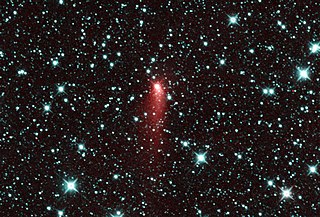
C/2013 UQ4 (Catalina) is a Solar System comet that came close to the Earth on July 10, 2014, at a distance of 0.314 AU (47,000,000 km; 29,200,000 mi).

2015 TB145 is a sub-kilometer asteroid, classified as near-Earth object and potentially hazardous asteroid of the Apollo group, approximately 650 meters (2,000 feet) in diameter. It safely passed 1.27 lunar distances from Earth on 31 October 2015 at 17:01 UTC, and passed by Earth again in November 2018.

Comet 252P/LINEAR is a periodic comet and near-Earth object discovered by the LINEAR survey on April 7, 2000. The comet is a Jupiter family comet, meaning that it passes quite close to the orbit of Jupiter.

460P/PanSTARRS (also known with the provisional designation P/2016 BA14) is a near-Earth object and periodic comet of the Jupiter family, with an orbital period of 5.25 years. In March 2016 it passed at distance of 2.2 million miles (3.5 million km, or 9 lunar distances) from Earth. It was the closest approach by a comet since 1770 and 3rd closest recorded comet to Earth. The close flyby enabled the size of the nucleus to be calculated at about 1 km (0.62 mi) in diameter, which was much bigger than expected. The comet is very dark, reflecting about 2-3 percent of the visible light, about the same as a charcoal briquette. It has a very similar orbit as numbered comet 252P/LINEAR, and may be related to it (e.g. split off of).

Comet C/2018 V1 (Machholz–Fujikawa–Iwamoto) is a minor body that follows a slightly hyperbolic orbit. It was visually discovered on 7 November 2018 by Donald Machholz using an 18.5-inch reflecting telescope and it reached perihelion on 3 December 2018.

2I/Borisov, originally designated C/2019 Q4 (Borisov), is the first observed rogue comet and the second observed interstellar interloper after ʻOumuamua. It was discovered by the Crimean amateur astronomer and telescope maker Gennadiy Borisov on 29 August 2019 UTC.

C/2019 Y4 (ATLAS) was a comet with a near-parabolic orbit discovered by the ATLAS survey on December 28, 2019. Early predictions based on the brightening rate suggested that the comet could become as bright as magnitude 0 matching the brightness of Vega. It received widespread media coverage due to its dramatic increase in brightness and orbit similar to the Great Comet of 1844, but on March 22, 2020, the comet started disintegrating. Such fragmentation events are very common for Kreutz Sungrazers. The comet continues to fade and did not reach naked eye visibility. By mid-May, comet ATLAS appeared very diffuse even in a telescope. C/2019 Y4 (ATLAS) has not been seen since May 21, 2020.

C/2020 F3 (NEOWISE) or Comet NEOWISE is a long period comet with a near-parabolic orbit discovered on March 27, 2020, by astronomers during the NEOWISE mission of the Wide-field Infrared Survey Explorer (WISE) space telescope. At that time, it was an 18th-magnitude object, located 2 AU away from the Sun and 1.7 AU away from Earth.

C/2014 UN271 (Bernardinelli–Bernstein), simply known as C/2014 UN271 or Comet Bernardinelli–Bernstein (nicknamed BB), is a large Oort cloud comet discovered by astronomers Pedro Bernardinelli and Gary Bernstein in archival images from the Dark Energy Survey. When first imaged in October 2014, the object was 29 AU (4.3 billion km; 2.7 billion mi) from the Sun, almost as far as Neptune's orbit and the greatest distance at which a comet has been discovered. With a nucleus diameter of at least 120 km (75 mi), it is the largest Oort cloud comet known. It is approaching the Sun and will reach its perihelion of 10.9 AU (just outside of Saturn's orbit) in January 2031. It will not be visible to the naked eye because it will not enter the inner Solar System.
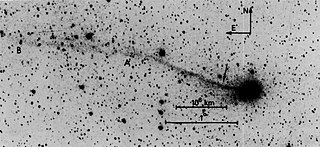
C/1979 Y1 (Bradfield), also known as Comet 1979X and 1979l, is a long period comet discovered by William A. Bradfield on 24 December 1979. The comet has an orbital period of 308 ± 6 years and last passed perihelion on 21 December 1979. It is considered to be the parent body of the July Pegasids meteor shower. It is expected to next come to perihelion around 2287.
